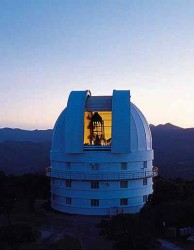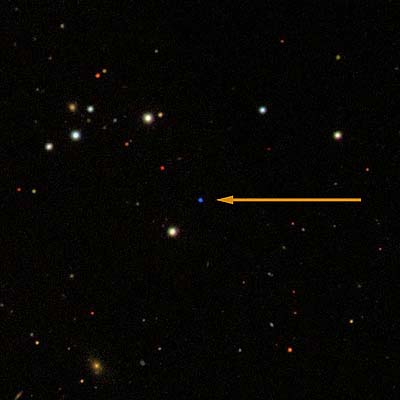Most of the stars in the universe will end their lives as white dwarfs, the class of star that’s just a remnant of the star’s former self when all the nuclear fuel in the star’s core has burned. Studying these white dwarfs gives astronomers an important view of the endpoint of most stars. Recently, researchers from the University of Texas have confirmed the existence of a new type of dwarf star, a “pulsating carbon white dwarf.†Since pulsating stars can reveal the inner workings of these stars, astronomers are hoping now to be able to learn more about what goes on inside white dwarf stars.
Until recently, astronomers knew of only two types of white dwarf stars: those that have an outer layer of hydrogen (about 80 percent), and about those with an outer layer of helium (about 20 percent), whose hydrogen shells have somehow been stripped away. Then in 2007, a third type was discovered, a very rare “hot carbon white dwarf.†These stars have had both their hydrogen and helium shells stripped off, leaving their carbon layer exposed.
After these new carbon white dwarfs were announced, Michael H. Montgomery from the University of Texas calculated that pulsations in these stars were possible. Similar to how geologists study seismic waves from earthquakes to understand what goes on in Earth’s interior astronomers can study the changes in light from a pulsating star to “look†into the star’s interior. In fact, this type of star-study is called “asteroseismology.â€
Montgomery and his team began a systematic study of carbon white dwarfs with the Struve Telescope at McDonald Observatory, looking for pulsators. They discovered a pulsating star about 800 light-years away in the constellation Ursa Major, (called SDSS J142625.71+575218.3) fits the into this category. Its light intensity varies regularly by nearly two percent about every eight minutes.

“The discovery that one of these stars is pulsating is remarkably important,” said National Science Foundation astronomer Michael Briley. “This will allow us to probe the white dwarf’s interior, which in turn should help us solve the riddle of where the carbon white dwarfs come from and what happens to their hydrogen and helium.”
The star lies about ten degrees east northeast of Mizar, the middle star in the handle of the Big Dipper. This white dwarf has about the same mass as our Sun, but its diameter is smaller than Earth’s. The star has a temperature of 35,000 degrees Fahrenheit (19,500 C), and is only 1/600th as bright as the Sun.
Original News Source: McDonald Observatory Press Release


Interesting. Now, somebody ought to develop an observing program like…Long Undulating Carbon Yield. Then we can have LUCY in the Sky….with Diamonds. pete
pete: that was terrible.
Pete:
+1 for beatles reference
-10 for over-used beatles reference
/hello fark
Does Oxygen White Dwarf exist?
*Shakes head at Lucy joke*
Throw in seven of the hydrogen/helium remnants and you’ve got Carbon White and the Seven Dwarfs.
Best Beatles reference ever
All over-wrought and under-whelming references aside, this article made me think “like a diamond in the sky” and I wonder if these carbon starts are just pumping out diamonds?
And are there advanced races that harvest star-forged diamonds, not to mention the diamonds supposedly raining down on Neptune!?
These things I wonder…
To understand the nature of white dwarfs and something about the nature of their evolution, I would recommend reader look at Icko Iben Jr, 1985 article “The Life and Times of an Intermediate Mass Star – in Isolation/in a Binary”; QJRAS, 26, 1, (1985)
You can download the article from the ADS;
http://adsabs.harvard.edu/abs/1985QJRAS..26….1I
or directly download the article in pdf at;
http://articles.adsabs.harvard.edu/cgi-bin/nph-iarticle_query?1985QJRAS..26….1I&data_type=PDF_HIGH&whole_paper=YES&type=PRINTER&filetype=.pdf
Although this is a technical article, reader here should easily understand it. Perhaps the best section is Figure 19, which shows the mass of the white dwarf against the initial star mass, and shows the typical composition of the white dwarf as mass increases.-including the Carbon-Oxygen White Dwarfs (CO White Dwarfs).
Posted this link in http://www.surfurls.com
If this is a white dwarf, why does it look so blue? About the bluest star I have ever seen.
Those interested might like to read the “Life and Times of an Intermediate Mass Star – in Isolation/in a Binary”; QJRAS, 26, 1, (1985) You can download the article from the ADS;
Although this is a technical article, reader here should easily understand it. Perhaps the best section is Figure 19, which shows the mass of the white dwarf against the initial star mass, and shows the typical composition of the white dwarf as mass increases.-including the Carbon-Oxygen White Dwarfs (CO White Dwarfs) .
Furthermore, this article confuses me, as the three types of white dwarfs, at least there ashes, Helium, Carbon-Oxygen, Oxygen-Neon White Dwarfs.
Also Carbon-Oxygen white dwarfs have been established for ages, though hot ones are rarer. Obviously, stars that pulsate as WD, must lie inside the instability strip on the H-R diagram, which is placed at 12,300K at solar luminosities. These are the ZZ Ceti variables, whose pulsations are in multiple periods or non-radial modes.
Q. What I don’t understand is how these pulsations are believed caused – especially if they are away instability strip?
Would these be DQ class white dwarfs?
This discovery took place over a year ago. Interested in pulsating neutron stars or pulsars, I searched “pulsating white dwarfs” at google.com just to check in case it was true, because there, I have good luck sometimes searching for something I didn’t know about. Like a pulsar spinning over 1000 times per second, a white dwarf completing a rotation in minutes, a neutron star spinning only once every 12 seconds, a planet around a quadruple star system, or a planet that orbits it’s star in less than 2 days, the Sun possibly having a red dwarf star or brown dwarf companion, a new mini-solar system forming around a brown dwarf only 12 times Jupiter’s mass, and a mass that might indeed be a red dwarf star although ant most surprising, it’s only 17% larger in diameter than Jupiter, while a planet less massive than Jupiter is 70% larger in diameter than Jupiter. I was hoping there would be a gas planet larger than any red dwarf star, because a planet larger than a star, that’s amazing. Over a year ago, I saved a motion picture of a pulsating white dwarf brightening and dimming. I still have the image. I love google.com.
As for what causes it, better equipment will reveal more data that we cannot see now. It is likely that the pulsing may be caused by material drawn toward the WD gravitationally while the strong magnetic field interacts with it periodically or funnels it down to the surface which then radiates it outward.
Degenerate matter has the habit of shrinking when more matter is added and there is unlikely any symmetrical infall of matter onto the WD. The shrinking is a change in position of matter in the magetic field and that should induce a pulse. The degenerate electrons cannot be the source of the magnetic field pulses but this does not mean that the nuclei are degenerate. They can shift energy levels and radiate energy.